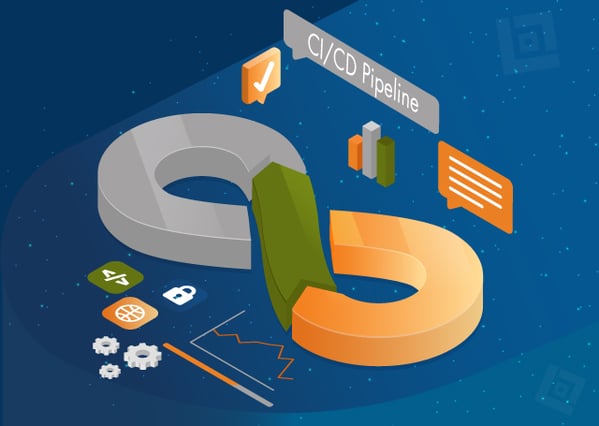
The central tenet of the practice of DevOps are the twin processes of continuous integration and continuous delivery. In order to implement an effective framework that helps organizations streamline production processes to reduce bugs and release software products faster, it is fundamental to understand how the CI/CD pipeline works.
However, it is also important to understand that stringent adherence to technical practices might not always yield the desired results. Technical teams need to be mindful of how DevOps and agile methodologies work together in consonance to contribute to faster delivery cycles. In short, for a successful CI/CD implementation, there needs to be an overarching recognition and appreciation of the cross-functional cultural shift within technical teams to support an effective CI/CD pipeline.
In this blog, we will take a deep dive into what the CI/CD pipeline is, and the benefits that it offers.
What is CI/CD Pipeline?
In the traditional software development approach, the teams normally take almost five to six months to spread main releases. The reasons for this prolonged timeline include bug fixes, implementing improvements to the functionality and reliability of the software’s existing features, and introducing new features. These activities take a lot of time and are prone to human error. This gave rise to the whole concept of the CI/CD pipeline.
Continuous Integration (CI), is a practice of continuously integrating and testing code changes. The code changes to an application are regularly built and tested automatically. Whereas Continuous Delivery/Deployment or CD is the methodology that comes after Continuous Integration in which the changes to an application are uploaded to the repositories so that the changes can be deployed to the different application environments (Dev/QA/Production) later on.
When we combine the phases of CI and CD in an automated manner with the help of pipelines we call it a pipeline. A CI/CD pipeline is a process that drives software development through a path of building, testing, deploying, and monitoring.
Different Phases of CI/CD
The CI/CD can be divided into below high-level phases:
- Build: This phase is responsible to fetch the changes and build the application in a given environment.
- Test: Runs the automated tests and store the generated artifacts (if any).
- Deploy/Release: Provisions the deployment environment and delivers the changes within the same.
- Monitor: Continuous monitoring of the application, and underlying infrastructure so that in the event of any failure appropriate action can be taken.
Who Requires a CI/CD Pipeline and Why?
DevOps teams require a CI/CD pipeline to deliver code changes frequently and reliably. The process can optimize the development process during the integration, testing, delivery, and deployment phases. Also known as agile methodology, it allows development teams to meet business requirements, maintain code quality, and ensure application security while automating deployment stages. Organization(s) requires CI/CD who wants to:
- Continuously develop, test, deploy and monitor the applications
- Save time, improve quality and increase productivity so that faster and more stable releases can be delivered
It is important for businesses to automate the stages of software development in order to deliver the feature/product to the end users with high velocity and with efficiency. Also, every CI/CD pipeline is unique as per the requirements of the organization. CI/CD pipeline eliminates the risk of manual errors and provides regular feedback to the developers in a loop.
Benefits of CI/CD pipeline
In essence, CI/CD pipeline is a methodology that enables businesses to produce high-quality software with a minimal amount of coding errors or security bugs. This leads to software development life cycles that are streamlined and incredibly effective. Following are some of the advantages when CI/CD methodologies are properly implemented:
-
Smaller Code Changes
In essence, CI/CD strategies enable you to gradually incorporate smaller segments of code into your entire application which can be tested automatically. Integrating and testing a small amount of code is much simpler and easier than integrating and testing large amounts of code changes.
-
Eliminate Failures
CI/CD pipelines allow for integrating smaller batches of code, making it easier to deal with potential issues later. Additionally, as soon as these smaller components are merged into the code repository, they can be accurately tested. The team is better able to identify and address problems as they arise rather than waiting until too much work has been completed. Using CI/CD pipelines also guarantees quick failure identification. That's a great solution for large teams, especially when there are remote developers involved and communication can be difficult.
-
Accelerate the Release Rate
Naturally, bugs are fixed more quickly if they are discovered earlier. As long as the developers keep writing code, it guarantees increasing release rates. In other words, CI/CD pipelines enable the consistent deployment and integration of code, preparing it for release. The automated delivery pipelines assist companies in better responding to customer demands by having the potential to accelerate the software development process.
-
Enhance Productivity
Automated delivery pipelines guarantee fewer errors and prompt quick error detection when they do occur. It implies that your team members are not required to make various code changes to concentrate on creating a high-quality product. Additionally, if you combine velocity and productivity, you'll produce a product that will enable you to outperform your competitors.
-
Measurable Progress
Many of the CI/CD pipeline support tools offer you access to a wide range of metrics such as build times, test coverage, defect rates, and test fix times. With the help of this information, you can spot potential problem areas and keep developing your pipeline. A need for more capacity may be indicated by slower builds, whereas a problem with a process or culture may be indicated by an increase in average fix times.
Practices for Implementing a CI/CD Pipeline
The CI/CD pipeline offers many advantages, however, certain factors need to be considered before implementing it successfully. It can be difficult to make decisions without a lot of trial and error about how exactly to use the techniques and what modifications you might need to make to your processes. We'll discuss the different practices that can help you increase the efficiency of your CI/CD pipeline.
-
Utilize the “Security First” Principle
In a world where breaches and vulnerabilities continue to cause significant reputational and financial losses to businesses of all sizes and capabilities, the importance of security cannot be overstated. Since the CI/CD system grants access to your codebase and requires credentials to deploy in different environments, it is generally the main target. In light of this, you ought to think about isolating your CI/CD pipeline and installing them in safe internal networks.
-
Assess Your Organization’s Readiness for Microservices
Microservices architecture is the best approach for DevOps implementation. Re-architecting your current applications can be a difficult task, so you might want to take an incremental approach and keep your mission-critical systems running while incorporating the new architecture around them. This will facilitate the gradual substitution of the new architecture for the outdated system.
-
Utilize Version Control and Tracking Software
You can collaborate with distributed teams more easily and gain better visibility into the development of your software with the aid of tools like Jira and Bugzilla. You will also require a version control system, such as Git, which establishes a "centralized database" for your team, enables tracking of code-base changes, and comes in handy whenever a rollback is essential. GitOps can greatly increase your MTTR by allowing the teams to communicate and incorporate changes into the shared repository.
-
Only Build Once
Any method that requires building source code more than once should be abandoned. You should only carry out that step once and then advertise your binaries, even if the software needs to be built, packaged, or bundled. The build process serves as the initial step in the CI/CD cycle to integrate the software in a safe environment in the majority of successful CI implementations. This prevents oversights and lessens the possibility that mistakes will be made and/or overlooked in the future. The created artifact should also be versioned and consistently uploaded to Git so that the build does not modify when it is pulled.
-
Prioritize Automating Processes and Tests
Choosing which processes to automate first can be challenging for organizations making the switch from manual to automated processes, even though an incremental approach to automated processes sounds good. For example, it is advantageous to automate the procedure for first compiling the code. It makes sense to perform automated smoke tests because developers must commit code regularly. Usually, automated unit tests come first to lighten the load on developers.
As a result, functional testing can be automated, then UI testing. Contrary to UI tests, which require more frequent changes, functional tests typically do not necessitate frequent updates to the automation script. The main goal is to rationally prioritize automation by considering all potential dependencies and assessing their effectiveness.
Conclusion
The CI/CD pipeline helps to level the playing field for technical teams, especially smaller ones that are resource and budget constrained, to accelerate product releases while reducing bugs and errors. While longer software release cycles are better in terms of test coverage, they are not optimal from the cost perspective. With an effective CI/CD pipeline, technical teams can reduce both costs, as well as software release timelines to meet the customers’ needs to launch products quickly to market. At QASource, we follow a strategic three-way process, to ensure a successful implementation of DevOps CI/CD to build high-quality products. To know more, contact our experts now.


